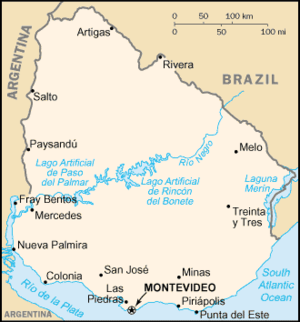Geography of Uruguay
|
|
Uruguay_T2.png
Location: Southern South America, bordering the South Atlantic Ocean, between Argentina and Brazil
Geographic coordinates: Template:Coor dm
Map references: South America
Area:
total:
176,220 sq km
land:
173,620 sq km
water:
2,600 sq km
Area - comparative: slightly smaller than the state of Washington
Land boundaries:
total:
1,564 km
border countries:
Argentina 579 km, Brazil 985 km
Coastline: 660 km
Maritime claims:
continental shelf:
200-m depth or to the depth of exploitation
territorial sea:
200 nm; overflight and navigation guaranteed beyond 12 nm
Climate: warm temperate; freezing temperatures almost unknown
Terrain: mostly rolling plains and low hills; fertile coastal lowland
Elevation extremes:
lowest point:
Atlantic Ocean 0 m
highest point:
Cerro Catedral 514 m
Natural resources: arable land, hydropower, minor minerals, fisheries
Land use:
arable land:
7%
permanent crops:
0%
permanent pastures:
77%
forests and woodland:
6%
other:
10% (1997 est.)
Irrigated land: 7,700 sq km (1997 est.)
Natural hazards: seasonally high winds (the pampero is a chilly and occasional violent wind which blows north from the Argentine pampas), droughts, floods; because of the absence of mountains, which act as weather barriers, all locations are particularly vulnerable to rapid changes in weather fronts
Environment - current issues: water pollution from meat packing/tannery industry; inadequate solid/hazardous waste disposal
Environment - international agreements:
party to:
Antarctic Treaty, Antarctic-Environmental Protocol, Biodiversity, Climate Change, Desertification, Endangered Species, Environmental Modification, Hazardous Wastes, Law of the Sea, Nuclear Test Ban, Ozone Layer Protection, Ship Pollution, Wetlands, Whaling
signed, but not ratified:
Climate Change-Kyoto Protocol, Marine Dumping, Marine Life Conservation
- See also : Uruguayfr:Géographie de l'Uruguay

